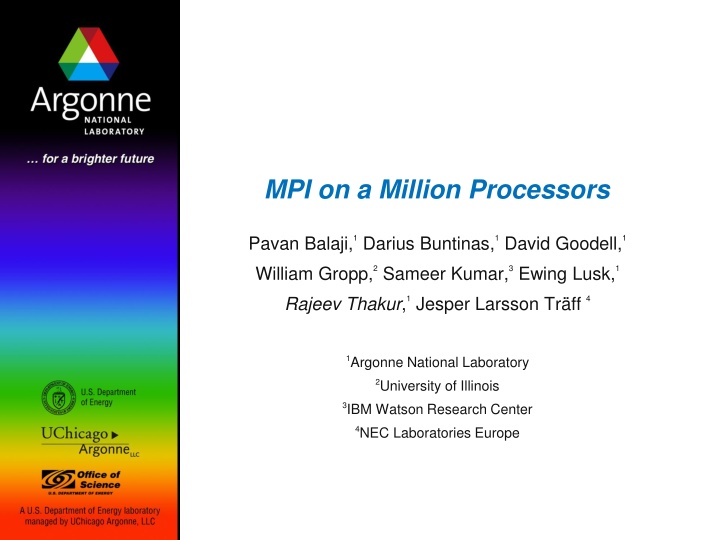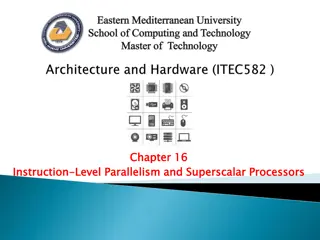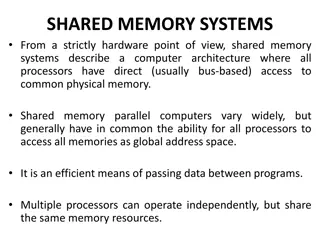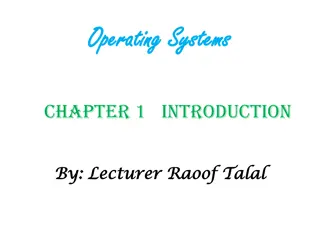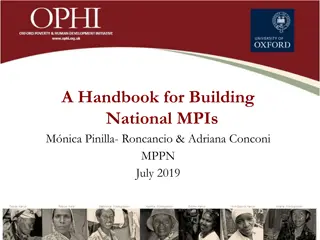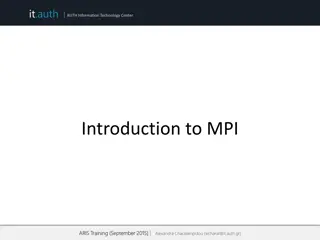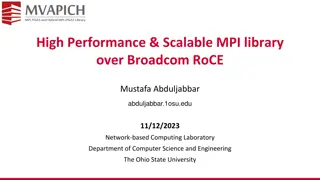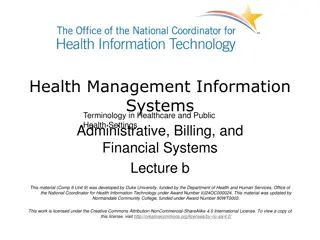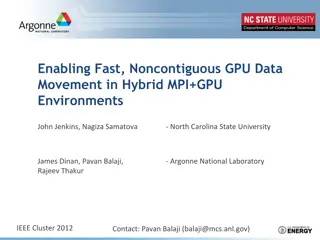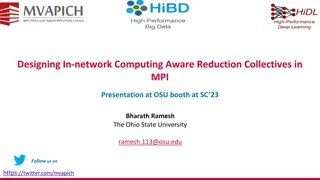MPI on a Million Processors
Welcome to the LSWA Youth Advisory Committee meeting where updates will be provided, new program introductions made, and discussions on out-of-school youth programs. Join the committee members and engage in network updates and agency announcements for upcoming schedules
Download Presentation

Please find below an Image/Link to download the presentation.
The content on the website is provided AS IS for your information and personal use only. It may not be sold, licensed, or shared on other websites without obtaining consent from the author.If you encounter any issues during the download, it is possible that the publisher has removed the file from their server.
You are allowed to download the files provided on this website for personal or commercial use, subject to the condition that they are used lawfully. All files are the property of their respective owners.
The content on the website is provided AS IS for your information and personal use only. It may not be sold, licensed, or shared on other websites without obtaining consent from the author.
E N D
Presentation Transcript
MPI on a Million Processors Pavan Balaji, 1Darius Buntinas, 1David Goodell, 1 William Gropp, 2Sameer Kumar, 3Ewing Lusk, 1 Rajeev Thakur, 1Jesper Larsson Tr ff 4 1Argonne National Laboratory 2University of Illinois 3IBM Watson Research Center 4NEC Laboratories Europe
Introduction Systems with the largest core counts in June 2009 Top500 list Juelich BG/P LLNL BG/L Argonne BG/P 163,840 cores Oak Ridge Cray XT5 150,152 cores LLNL BG/P (Dawn) 294,912 cores 212,992 cores 147,456 cores In a few years, we will have systems with a million cores or more For example, in 2012, the Sequoia machine at Livermore will be an IBM Blue Gene/Q with 1,572,864 cores (~1.6 million cores) 2
MPI on Million Core Systems Vast majority of parallel scientific applications today use MPI Some researchers and users wonder (and perhaps even doubt) whether MPI will scale to large processor counts In this paper, we examine the issue of how scalable is MPI What is needed in the MPI specification What is needed from implementations We ran experiments on up to 131,072 processes on Argonne s IBM BG/P (80% of the full machine) Tuned MPI implementation to reduce memory requirements We consider issues in application algorithmic scalability and using MPI in other ways to improve scalability in applications 3
Factors Affecting Scalability Performance and memory consumption A nonscalable MPI function is one whose time or memory consumption per process increase linearly (or worse) with the number of processes (all else being equal) For example If time taken by MPI_Comm_spawn increases linearly or more with the no. of processes being spawned, it indicates a nonscalable implementation of the function If memory consumption of MPI_Comm_dup increases linearly with the no. of processes, it is not scalable Such examples need to be identified and fixed (in the specification and in implementations) The goal should be to use constructs that require only constant space per process 4
Scalability Issues in the MPI Specification Some function parameters are of size O(nprocs) e.g., irregular (or v ) version of collectives such as MPI_Gatherv Extreme case: MPI_Alltoallw takes six such arrays On a million processes, that requires 24 MB on each process On low-frequency cores, even scanning through large arrays takes time (see next slide) MPI Forum is working to address this issue (proposal by Jesper and Torsten) 5
Zero-byte MPI_Alltoallv time on BG/P This is just the time to scan the parameter array to determine it is all 0 bytes. No communication performed. 6
Scalability Issues in the MPI Specification Graph Topology In MPI 2.1 and earlier, requires the entire graph to be specified on each process Fixed in MPI 2.2 distributed graph topology One-sided communication Synchronization functions turn out to be expensive Being addressed by RMA working group of MPI-3 Representation of process ranks Explicit representation of process ranks in some functions, such as MPI_Group_incl and MPI_Group_excl Concise representations should be considered 7
Scalability Issues in the MPI Specification All-to-all communication Not a scalable communication pattern Applications may need to consider newer algorithms that do not require all-to-all Fault tolerance Large component counts will result in frequent failures Greater resilience needed from all components of the software stack MPI can return error codes, but need more support than that Being addressed in the fault tolerance group of MPI-3 8
MPI Implementation Scalability In terms of scalability, MPI implementations must pay attention to two aspects as the number of processes is increased: memory consumption of any function, and performance of all collective functions Not just collective communiation functions that are commonly optimized Also functions such as MPI_Init and MPI_Comm_split 9
Process Mappings MPI communicators maintain mapping from ranks to processor ids This mapping is often a table of O(nprocs) size in the communicator Need to explore more memory-efficient mappings, at least for common cases More systematic approaches to compact representations of permutations (research problem) 10
NEK5000: Communicator Memory Consumption Maximum Number of Communicators 9000 Number of Communicators 8000 7000 6000 5000 Default 4000 Buffer Pool 3000 2000 1000 0 4 8 1K 2K 4K 8K 16 32 64 16K 32K 64K 128 256 Number of Processes 512 128K NEK5000 code failed on BG/P at large scale because MPI ran out of communicator memory. We fixed the problem by using a fixed buffer pool within MPI and provided a patch to IBM. 11
MPI Memory Usage on BG/P after 32 calls to MPI_Comm_dup Percentage Memory Usage (32 dups) 25 Default % System Memory Used 20 Buffer Pool 15 10 5 0 4 8 16 32 64 128 256 512 1K 2K 4K 8K 16K 32K 64K128K Number of Processes Using a buffer pool enables all collective optimizations and takes up only a small amount of memory 12
Scalability of MPI_Init Cluster with 8 cores per node. TCP/IP across nodes Setting up all connections at Init time is too expensive at large scale; must be done on demand as needed 13
Scalable Algorithms for Collective Communication MPI implementations typically use O(lg p) algorithms for short messages (binomial tree) O(m) algorithms, where m=message size, for large messages E.g., bcast implemented as scatter + allgather O(lg p) algorithms can still be used on a million processors for short messages However, O(m) algorithms for large messages may not scale, as the message size in the allgather phase can get very small E.g., for a 1 MB bcast on a million processes, the allgather phase involves 1 byte messages Hybrid algorithms that do logarithmic bcast to a subset of nodes, followed by scatter/allgather may be needed Topology-aware pipelined algorithms may be needed Use network hardware for broadcast/combine 14
Enabling Application Scalability Applications face the challenge of scaling up to large numbers of processors A basic question is Is the parallel algorithm used by the application itself scalable (independent of MPI)? Needs to be fixed by the application Some features of MPI that may not be currently used by an application could play an important role in enabling the application to run effectively on more processors In many cases, application code may not require much change 15
Higher Dimensional Decompositions with MPI Many applications use 2D or 3D meshes, but parallel decomposition is only along one dimension Results in contiguous buffers for MPI sends and receives Simple, but not the most efficient for large numbers of processors 2D or 3D decompositions are more efficient Results in noncontiguous communication buffers for sending and receiving edge or face data MPI (or a library) can help by providing functions for assembling MPI datatypes that describe these noncontiguous areas Efficient support for derived datatypes needed 16
Enabling Hybrid Programming Million processors need not mean million processes On future machines, as the amount of memory per core decreases, applications may want to use a shared-memory programming model on a multicore node, and MPI across nodes MPI supports this transition by having clear semantics for interoperation with threads Four levels of thread safety that can be required by an application and provided by an implementation Works as MPI+OpenMP or MPI+Pthreads or other approaches Hybrid programming working group in MPI-3 Forum exploring further enhancements to support efficient hybrid programming See Marc Snir proposal on end points 17
Use of MPI-Based Libraries to Hide Complexity MPI allows you to build higher-level libraries that provide extremely simple programming models that are both useful and scalable Example: Asynchronous Dynamic Load Balancing Library (ADLB) Used in GFMC (Green s Function Monte Carlo) code in UNEDF SciDAC project GFMC used a nontrivial master-worker model with a single master; didn t scale beyond 2000 processes on Blue Gene Shared Work queue Master Worker Worker Worker Worker Worker 18
ADLB Library Provides a scalable distributed work queue, with no one master Application processes can simply put and get work units to the queue Implemented on top of MPI, hence is portable Enables GFMC application to scale beyond 30,000 processes Worker Worker Worker Worker Worker Shared Work queue 19
Conclusions MPI is ready for scaling to a million processors barring a few issues that can be (and are being) fixed Nonscalable parts of the MPI standard include irregular collectives and virtual graph topology Need for investigating systematic approaches to compact, adaptive representations of process groups MPI implementations must pay careful attention to the memory requirements and eliminate data structures whose size grows linearly with the number of processes For collectives, MPI implementations may need to become more topology aware or rely on global collective acceleration support MPI s support for building libraries and clear semantics for interoperation with threads enable applications to use other techniques to scale when limited by memory or data size 20
